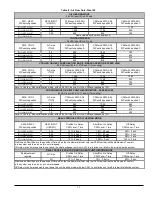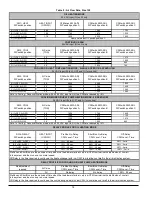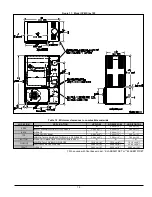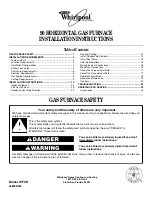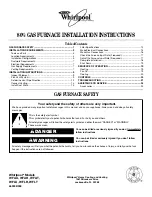
4
2.2
SAFE INSTALLATION REQUIREMENTS
WARNING
Installation or repairs performed by unqualified persons
can result in hazards to them and others. Installation
MUST conform to local codes or, in the absence of
same, to codes of the country having jurisdiction.
The information contained in this manual is intended for
use by a qualified service technician familiar with safety
procedures and quipped with the proper tools and test
instruments.
Failure to carefully read and follow all instructions in
this manual can result in death, furnace malfunction
and/or property damage.
WARNING
FIRE HAZARD
The furnace must be installed in a level position, never
where it will slope toward the front. If the furnace is not
installed level, oil will drain into the furnace vestibule
and create a fire hazard.
NOTE: It is the personal responsibility and obligation of the
customer to contact a qualified installer to ensure that the
installation conforms to governing local and/or national
codes and ordinances
a. This furnace is NOT approved for installation in mobile
homes, trailers or recreational vehicles;
b. Do NOT use this furnace as a construction heater or to
heat a building under construction;
c.
There must be a sufficient supply of fresh air for
combustion as well as ventilation in the area where the
furnace is located;
d. Use only the type of fuel oil approved for this furnace
(see section 1.2 of this manual). Overfiring will result in
heat exchanger failure and cause dangerous operating
conditions;
e. Visually check all oil line joints for signs of leakage;
f.
Connect furnace to the chimney;
g. The points in Part 3 “Operation” are vital to the proper
and safe operation of the heating system. Take the time
to ensure that all steps were followed;
h. Follow the regulations of the NFPA No.31 (in the USA)
and CSA B-139 (in Canada) or local codes for placing
and installing the oil storage tank;
i.
Follow a regular service and maintenance schedule for
efficient and safe operation;
j.
Before servicing, allow furnace to cool down. Always
shut off electricity and fuel to furnace when servicing.
This will prevent electrical shock or burns;
k.
Seal supply and return air ducts;
l.
The vent system MUST be checked to determine that it
is the correct type and size;
m. Install correct filter type and size;
n. Unit MUST be installed so that electrical components
are protected from direct contact with water.
2.3
SAFETY RULES
Your unit is built to provide many years of safe and
dependable service, provided it is properly installed and
maintained. However, abuse and/or improper use can
shorten the life of the unit and create hazards for you, the
owner.
2.3.1
Detector
a. The U.S. Consumer Product Safety Commission
recommends that users of oil-burning appliances install
carbon monoxide detectors. There can be various
sources of carbon monoxide in a building or dwelling.
The sources could be gas-fired clothes dryers, gas
cooking stoves, water heaters, furnaces, gas-fired
fireplaces, wood fireplaces, and several other items.
Carbon monoxide can cause serious bodily injury
and/or death. Therefore, to help alert people to
potentially dangerous carbon monoxide levels, you
should have carbon monoxide detectors listed by a
nationally
recognised
agency
(ex.
Underwriters
Laboratories
or International Approval Services)
installed and maintained in the building or dwelling (see
Note below).
b. There can be numerous sources of fire or smoke in a
building or dwelling. Fire or smoke can cause serious
bodily injury, death, and/or property damage. Therefore,
in order to alert people to potentially dangerous fire or
smoke, you should have fire and smoke detectors listed
by Underwriters Laboratories installed and maintained
in the building or dwelling (see Note below).
NOTE: The manufacturer of your furnace does not test any
detectors and makes no representations regarding any
brand or type of detector.
CAUTION
Ensure that the area around the combustion air intake is
free of snow, ice and debris.
2.3.2
Freezing temperatures and your building
WARNING
FREEZING TEMPERATURE WARNING
Turn off water supply.
If your heater remains shut off during cold weather, the
water pipes could freeze and burst, resulting in serious
water damage.
If the structure is unattended during cold weather you should
take the following precautions:
a. Turn off main water supply into the structure and drain
the water lines if possible. Open faucets in appropriate
areas;
b. Have someone check the structure frequently during
cold weather to make sure it is warm enough to prevent
pipes from freezing. Contact a qualified service agency,
if required.
Содержание CBMAAA060120
Страница 21: ...21 Figure 13 Wiring diagram CVM ...
Страница 22: ...22 Figure 14 Parts list CVMAAR036105 B50003 Rev D ...
Страница 24: ...24 Figure 15 Parts list CVMAAR060120 B50004 Rev F ...
Страница 48: ...23 Figure 13 Diagramme électrique CVM ...
Страница 49: ...24 Figure 14 Liste de pièces CVMAAR036105 B50003 Rev D ...
Страница 51: ...26 Figure 15 Liste de pièces CVMAAR060120 B50004 Rev F ...

















